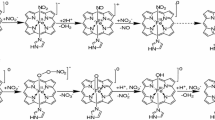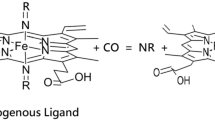The interaction between nitrite ion and bovine hemoglobin was investigated by a spectrofluorometric technique. The experimental results indicated that the interaction causes a static quenching of the fluorescence of bovine hemoglobin, that the binding reaction is spontaneous, and that H-bonding interactions play a major role in binding of this ion to bovine hemoglobin. The formation constant for this interaction was calculated. Based on Förster's theory of nonradiative energy transfer, the binding distance between this ion and bovine hemoglobin was determined. Furthermore, the interaction of nitrite ion with tyrosine and tryptophan was investigated with synchronous fluorescence. There was no significant shift of the maximum emission wavelength with interactions of the mentioned ion with bovine hemoglobin, which implies that interaction of nitrite ion with bovine hemoglobin does not affect the microenvironment around the tryptophan and tyrosine residues. Furthermore, the effect of nitrite ion on amino acid residues of bovine hemoglobin was studied by a molecular docking technique.
Similar content being viewed by others
References
P. Mikuška and Z. Večeřa, Anal. Chim. Acta, 495, 225–232 (2003).
A . Cockburn, G. Brambilla, M. L. Fernández, D. Arcella, L. R. Bordajandi, B. Cottrill, C. van Peteghem, and J. L. Dorne, Toxicol. Appl. Pharmacol., 270, 209–217 (2013).
C. S. Bruning-Fann, J. B. Kaneene, and Vet. Hum. Toxicol., 35, 521–538 (1993).
N. A. Campbell and J. B. Reece, Biology, Pearson, Benjamin Cummings (2008).
S. V. Lepeshkevich, J. Karpiuk, I. V. Sazanovich, and B. M. Dzhagarov, Biochemistry, 43, 1675–1684 (2004).
S. V. Lepeshkevich, M. V. Parkhats, I. I. Stepuro, and B. M. Dzhagarov, Biochim. Biophys. Acta, Proteins Proteomics, 1794, 1823–1830 (2009).
J. M. Berg, Biochemistry (Loose Leaf)&Bioportal Access Card, Macmillian Higher Education (2011).
B. D. Hames and N. M. Hooper, Biochemistry, Taylor & Francis (2005).
T. S. D. Nascimento, R. O. L. Pereira, H. L. D. Mello, and J. Costa, Rev. Bras. Anestesiol., 8, 651–664 (2008).
B. J. C. Fernandez-Frackelton, Rosen’s Emergency Medicine: Concepts and Clinical Practice, Mosby Elsevier (2009).
D. B. Kim-Shapiro, M. T. Gladwin, R. P. Patel, and N. Hogg, J. Inorg. Biochem., 99, 237–246 (2005).
J. Brooks, Proc. R. Soc. London, Ser. B, 123, 368–382 (1937).
M. P. Doyle and J. W. Hoekstra, J. Inorg. Biochem., 14, 351–358 (1981).
R. F. Steiner and I. Weinryb, Excited States of Proteins and Nucleic Acids, Plenum Press (1971).
ht tp://autodock.scripps.edu
Y. Q. Wang, H. M. Zhang, and B. P. Tang, J. Photochem. Photobiol., B, 100, 76–83 (2010).
R. Hirstch, In "Hemoglobin Disorders", Ed. R. Nagel, Humana Press (2003).
A. S. Ladokhin, Encyclopedia of Analytical Chemistry, John Wiley & Sons Ltd, Chichester (2000).
A. P. Demchenko and P. R. Callis, Advanced Fluorescence Reporters in Chemistry and Biology, Springer (2010).
Z. Hajihassan and A. Rabbani-Chadegani, J. Biomed. Sci., 16, 31–37 (2009).
D. Faulds, J. Balfour, P. Chrisp, and H. Langtry, Drugs, 41, 400–449 (1991).
J. R. Lakowicz, Principles of Fluorescence Spectroscopy, Springer, London (2009).
J. R. Lakowicz and G. Weber, Biochemistry, 12, 4161–4170 (1973).
W. R. Ware, J. Phys. Chem., 66, 455–458 (1962).
G. Weber, J. Phys. Chem., 99, 1052–1059 (1995).
P. D. Ross and S. Subramanian, Biochemistry, 20, 3096–3102 (1981).
A. N. Kapanidis, T. A. Laurence, N. K. Lee, E. Margeat, X. Kong, and S. Weiss, Acc. Chem. Res., 38, 523–533 (2005).
B. Valeur and J. C. Brochon, New Trends in Fluorescence Spectroscopy, Springer Press, Berlin, Germany (1999).
A. Haouz, S. E. Mohsni, C. Zentz, F. Merola, and B. Alpert, Eur. J. Biochem., 264, 250–257 (1999).
B. Valeur and J. C. Brochon, New Trends in Fluorescence Spectroscopy: Applications to Chemical and Life Sciences, Springer-Verlag GmbH (2001).
B. Valeur and M. N. Berberan-Santos, Molecular Fluorescence: Principles and Applications, Wiley (2012).
J. N. Miller, Proc. Anal. Div. Chem. Soc., 16, 203–208 (1979).
Author information
Authors and Affiliations
Corresponding author
Additional information
Abstract of article is published in Zhurnal Prikladnoi Spektroskopii, Vol. 82, No. 2, p. 319, March–April, 2015.
Rights and permissions
About this article
Cite this article
Madrakian, T., Bagheri, H. & Afkhami, A. Spectrofluorometric and Molecular Modeling Studies on Binding of Nitrite Ion with Bovine Hemoglobin: Effect of Nitrite Ion on Amino Acid Residues. J Appl Spectrosc 82, 322–328 (2015). https://doi.org/10.1007/s10812-015-0106-z
Published:
Issue Date:
DOI: https://doi.org/10.1007/s10812-015-0106-z




